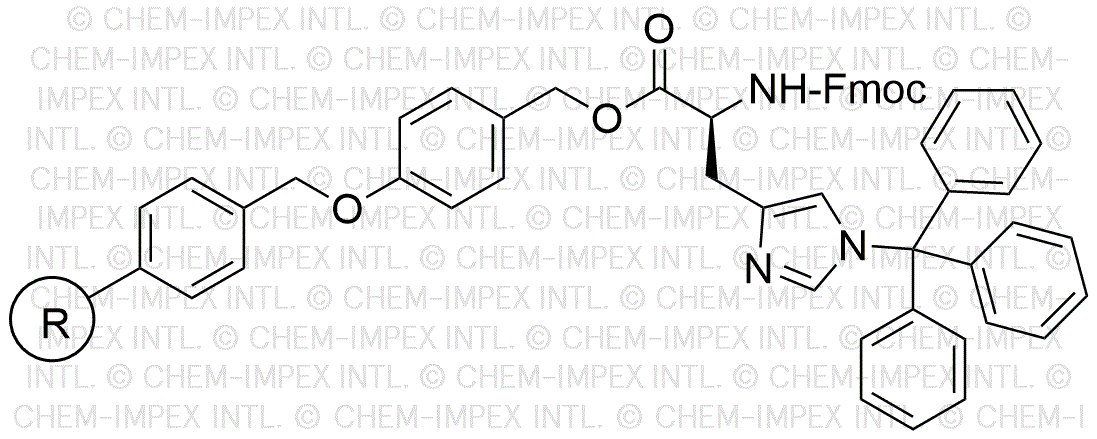Na-Fmoc-Nim-trityl-L-histidine 4-alkoxybenzyl alcohol is widely utilized in research focused on:
- Peptide Synthesis: This compound serves as a protecting group in the synthesis of peptides, allowing for selective reactions without interfering with other functional groups. This is crucial in developing complex peptides for pharmaceuticals.
- Drug Development: Its application in drug formulation helps in enhancing the stability and solubility of active pharmaceutical ingredients, making it valuable in the pharmaceutical industry for creating effective medications.
- Bioconjugation: The compound is used in bioconjugation processes, where it facilitates the attachment of drugs to antibodies or other biomolecules, improving targeted delivery systems in cancer therapy.
- Research in Biochemistry: It plays a significant role in biochemistry research, particularly in studying protein interactions and functions, which is essential for understanding various biological processes.
- Material Science: The compound can be utilized in the development of smart materials, where its unique properties contribute to creating responsive systems for sensors and drug delivery applications.
Informations générales
Propriétés
Sécurité et réglementation
Applications
Na-Fmoc-Nim-trityl-L-histidine 4-alkoxybenzyl alcohol is widely utilized in research focused on:
- Peptide Synthesis: This compound serves as a protecting group in the synthesis of peptides, allowing for selective reactions without interfering with other functional groups. This is crucial in developing complex peptides for pharmaceuticals.
- Drug Development: Its application in drug formulation helps in enhancing the stability and solubility of active pharmaceutical ingredients, making it valuable in the pharmaceutical industry for creating effective medications.
- Bioconjugation: The compound is used in bioconjugation processes, where it facilitates the attachment of drugs to antibodies or other biomolecules, improving targeted delivery systems in cancer therapy.
- Research in Biochemistry: It plays a significant role in biochemistry research, particularly in studying protein interactions and functions, which is essential for understanding various biological processes.
- Material Science: The compound can be utilized in the development of smart materials, where its unique properties contribute to creating responsive systems for sensors and drug delivery applications.
Documents
Fiches de données de sécurité (FDS)
La FDS fournit des informations de sécurité complètes sur la manipulation, le stockage et l’élimination du produit.
Spécifications du produit (PS)
Le PS fournit une description complète des propriétés du produit, notamment sa composition chimique, son état physique, sa pureté et les exigences de stockage. Il détaille également les plages de qualité acceptables et les applications prévues du produit.
Certificats d'analyse (COA)
Recherchez des certificats d'analyse (COA) en saisissant le numéro de lot du produit. Les numéros de lot et de lot se trouvent sur l'étiquette d'un produit, après les mots « Lot » ou « Lot de fabrication ».
Numéro de catalogue
Numéro de lot/série
Certificats d'origine (COO)
Ce certificat d'exploitation confirme le pays dans lequel le produit a été fabriqué, et détaille également les matériaux et composants utilisés et s'il est issu de sources naturelles, synthétiques ou autres sources spécifiques. Ce certificat peut être requis pour les douanes, le commerce et la conformité réglementaire.
Numéro de catalogue
Numéro de lot/série
Fiches de données de sécurité (FDS)
La FDS fournit des informations de sécurité complètes sur la manipulation, le stockage et l’élimination du produit.
DownloadSpécifications du produit (PS)
Le PS fournit une description complète des propriétés du produit, notamment sa composition chimique, son état physique, sa pureté et les exigences de stockage. Il détaille également les plages de qualité acceptables et les applications prévues du produit.
DownloadCertificats d'analyse (COA)
Recherchez des certificats d'analyse (COA) en saisissant le numéro de lot du produit. Les numéros de lot et de lot se trouvent sur l'étiquette d'un produit, après les mots « Lot » ou « Lot de fabrication ».
Numéro de catalogue
Numéro de lot/série
Certificats d'origine (COO)
Ce certificat d'exploitation confirme le pays dans lequel le produit a été fabriqué, et détaille également les matériaux et composants utilisés et s'il est issu de sources naturelles, synthétiques ou autres sources spécifiques. Ce certificat peut être requis pour les douanes, le commerce et la conformité réglementaire.

